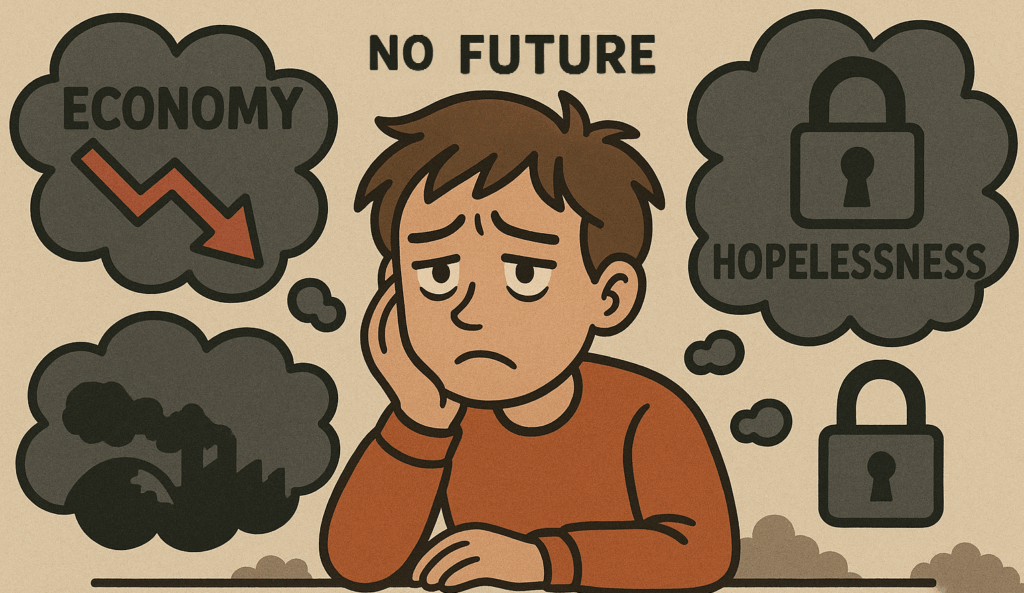Views: 23
The devastating influence of having no future.
Frans Vandenbosch 方腾波 01.07.2025

Losing faith in the future
In many western societies, the erosion of faith in the future has become one of the defining psychological and political crises of the 21st century. Empirical research demonstrates that “no-future” perceptions (what psychologists term future anxiety) correlate strongly with deteriorating mental health across age groups, manifesting as heightened anxiety, chronic stress, and depression. The toll is most acute among youth, for whom economic precarity, environmental collapse, and institutional decay converge into a paralyzing sense of hopelessness. This phenomenon, transcends individual psychology, shaping demographic trends, political disengagement, and even cultural production.
The crisis of futurelessness
Contemporary western societies face a growing epidemic of future anxiety, a psychological state where individuals perceive no viable path forward. Peer-reviewed studies confirm these “no-future” perceptions seriously damage mental health across all demographics, with youth being disproportionately affected.[1] The “No Future” syndrome manifests through three interconnected crises that threaten democratic stability.
Economic pessimism forms its foundation. With stagnant wages failing to keep pace with inflation (median wage growth at just 0.3% annually since 2000) [2], unaffordable housing (home prices outpacing incomes by 250% since 1980) [3], and rising household debt[4], millennials and Gen Z face unprecedented barriers to economic security.
Political disillusionment compounds this despair. Only 31% of Americans under 30 trust federal government to do what’s right [5], while 78% believe corporations dictate policy. [6] This institutional distrust creates paralysis when addressing existential threats like climate change or wealth inequality.
Social isolation completes this destructive triad. Community participation has plummeted: from 70% of Americans attending weekly social gatherings in 1970 to under 40% today. [7] Digital interactions now replace 68% of face-to-face communications among youth, [8] exacerbating what surgeons recently declared a “loneliness epidemic.” [9]
The consequences are both measurable and severe:
- Depression rates among under-30s increased 145% since 2010 [10]
- Birth rates hit record lows (1.64 births per woman) [11]
- Deaths of despair: (suicide/drug overdose) now claim 200 000 annually [12]
What began as punk rebellion (“No Future” lyrics in 1977 “God Save the Queen”) has become a mainstream malaise. Tocqueville foresaw this crisis when warning that democracy’s individualism could dissolve communal bonds. [13] Wang Huning’s analysis proves equally prescient; liberal democracies’ election cycles incentivize short-term thinking that exacerbates long-term crises. [14]
This essay argues that the “No Future” syndrome represents more than generational discontent; it is the canary in democracy’s coal mine. The solutions may require rethinking fundamental assumptions about progress, community, and governance itself.
Democracy, disintegration, and the sense of no future:
Alexis de Tocqueville and Wang Huning on America’s fate
When Alexis de Tocqueville journeyed through the United States in 1830, he saw a young republic brimming with energy, religious fervour, and democratic experimentation. Over 150 years later, Chinese political theorist Wang Huning travelled across the same country and returned with a markedly darker vision. His America Against America (1991) captured what he saw as a civilisation in decline, increasingly torn apart by its own contradictions. Although neither author used the phrase “no future,” both identified civilisational weaknesses that we today recognise as sources of generational despair, cultural exhaustion, and ideological fatigue in the West.
Tocqueville: democratic energies, moral dangers
Tocqueville admired the American experiment. In Democracy in America (1835/1840), he praised its decentralised governance, strong civic life, and religious underpinnings. However, he also foresaw deep risks:
- Individualism, while empowering, could become isolating.
- Materialism might replace spiritual purpose.
- Tyranny of the majority could suppress reasoned dissent.
Though optimistic, he warned that a democracy without moral restraint could drift into mediocrity and emptiness:
“A man’s admiration for absolute government is proportionate to the contempt he feels for those around him.”
For Tocqueville, the future was not guaranteed. America would thrive only if it could balance liberty with virtue. Still, he believed it had the cultural resources (especially religion) to do so.
The 21st century proved Tocqueville to be wrong.
Wang Huning: freedom without purpose
Wang Huning’s America Against America, written after a six-month research stay in 1988, reads like a postscript to Tocqueville’s warnings. Where Tocqueville saw possibilities, Wang saw contradictions realised. He witnessed a society with immense technological power and economic dynamism, but also one riddled with alienation, drug abuse, crime, and political fragmentation. To Wang, America had become:
“A society that emphasises freedom to the point that it erodes all order, all shared values.”
Wang identified a deeper pathology: America is spiritually empty. Its youth, he observed, lacked direction; families were fractured; universities no longer cultivated virtue but technocratic ambition. The nation had abandoned any sense of historical continuity or future orientation. Hence the title: America Against America: a nation at war with its own foundations.
The “No Future” phenomenon
While Wang did not use the term directly, his diagnosis aligns closely with what sociologists and psychologists today call the “no future” condition: a pervasive loss of long-term meaning, especially among youth. This is marked by:
- Declining birth rates, signalling lack of hope or purpose
- Rising depression and anxiety, especially among young people
- Distrust in institutions, including government, media, and even democracy itself
- Ideological exhaustion, where even liberalism loses moral and emotional traction
Tocqueville anticipated this erosion as a risk. Wang observed it as reality.
Wang’s critique is especially striking because it challenges the Western assumption that technological and economic progress automatically entail civilisational advancement. Instead, he argues that when freedom becomes an absolute, it destroys the moral architecture needed for long-term societal continuity. In other words, the liberty that promised the future has annihilated it.
Tocqueville’s hope versus Wang’s fatalism
Tocqueville believed that religion and civic engagement could counterbalance democracy’s excesses. Back in 1840, he saw churches, town halls, and newspapers as spaces where Americans learned self-discipline and moral responsibility. He warned of decadence, but never concluded that it was inevitable.
Wang, by contrast, saw no such counterweight. American religion had become fragmented and commercialised. Education lacked moral direction. Democracy itself had devolved into spectacle and conflict. His view was not merely critical, it was civilisationally fatalistic.
Where Alexis de Tocqueville saw a fragile future, Wang saw no future at all.
Civilisational schizophrenia
Both Alexis de Tocqueville and Wang Huning grasped that the fate of democracy hinges on more than elections or markets. It depends on a society’s ability to believe in itself across generations and to imagine a future worth building. Tocqueville saw the seeds of disintegration and warned against them. Wang saw the fruits of disintegration and described a society already turning against itself.
In this light, Wang’s America is not only politically fractured but metaphysically adrift: a nation without ancestors, without descendants, and thus without future.
China’s reflection in America’s mirror
It is significant that America Against America became very influential within China’s political elite. Wang, later an architect of China’s ideological strategy, offered his country not only a critique of the West but a warning against imitating it. His book subtly argues that the true strength of a civilisation lies not in freedom, but in cohesion, discipline, and purpose.
Tocqueville inspired generations of liberal democrats. Wang inspired China’s search for a post-liberal modernity, a society that embraces science and growth while rejecting Western-style individualism and political pluralism.
China’s bright future
In stark contrast to the future of the young generations in the West, the Chinese youngsters have a more than bright future. Due to a combination of efficient governance, stable economic growth, cultural strengths and social stability China has assured the future of its next generations.
The Chinese government operates with remarkable efficiency and a clear long-term vision, contrasting with the slower, bureaucratic systems in many Western countries. Relatively low wages and an abundancy of smart engineers remain key drivers of foreign investment, particularly in inland regions where labour costs are still competitive. China’s infrastructure is world-class, with modern highways, railways, ports, and urban transit systems built to the highest standards. The country also boasts an unparalleled number of highly skilled engineers, whose expertise fuels innovation and industrial growth.
Cultural factors further strengthen China’s position. Guanxi (relationship-based networking) is more effective than Western-style networking, fostering strong business connections. Chinese workers exhibit exceptional motivation, driven by a competitive education system and a societal emphasis on hard work. Unlike in Europe, where social safety nets sometimes reduce incentives to excel, Chinese employees willingly go the extra mile. Career planning is taken seriously, with students meticulously mapping their professional futures. Confucian values promote meritocracy and productivity, while strong family ties provide financial and moral support, particularly in small businesses.
China’s strict drug policies and emphasis on moral values create a stable social environment, free from the erosion seen in some Western societies. The historical one-child policy concentrated family resources on single children, driving economic ambition. Gender equality, a legacy of the New Culture Movement, ensures women have equal opportunities in education and business. A wide income gap acts as an incentive for upward mobility, while the absence of religious extremism ensures a safe investment climate.
Economic advantages include a vast pool of low-wage workers, both domestically and through China’s growing influence in Africa. The expanding middle class has surpassed Western counterparts in purchasing power, making China a dominant consumer market. Chinese businesses are highly adaptable, with rapid decision-making processes that outpace the rigid structures of Western firms. High savings rates mean many purchases, from cars to homes, are made in cash, reducing debt reliance.
China’s intellectual capital is another asset, with a population renowned for quick thinking and problem-solving. The sheer size of its population ensures massive domestic consumption and economic resilience. Overseas Chinese communities act as global economic ambassadors, while China’s financial reserves enable aggressive foreign investments and acquisitions. Finally, China’s cultural endurance (having outlasted ancient civilizations) suggests its continued rise. With unmatched flexibility, national confidence, and long-term vision, China is poised to surpass Western influence in the coming decades.
Thank you for reading! We’d love to hear your thoughts. Please share your comments here below and join the conversation with our community!
Dit artikel in het Nederlands: De crisis van toekomstloosheid
Endnotes
[1] Milman et al., Journal of Abnormal Psychology 130.4 (2021)
[2] Economic Policy Institute, Wage Stagnation Report (2023)
[3] Harvard Joint Center for Housing Studies (2022)
[4] Federal Reserve, Quarterly Household Debt Report (Q2 2023)
[5] Pew Research Center, Trust in Government Survey (2023)
[6] Edelman Trust Barometer (2023)
[7] Putnam, Bowling Alone (2000, updated 2020)
[8] NIH Social Media Study (2022)
[9] U.S. Surgeon General Advisory (2023)
[10] JAMA Psychiatry Longitudinal Study (2023)
[11] CDC National Vital Statistics Report (2023)
[12] Princeton Study on Mortality Trends (Case & Deaton, 2023)
[13] Tocqueville, Democracy in America Vol. II (1840)
[14] Wang, America Against America (1991)



Both China and Russia appear to have learned from the experiments in capitalism and socialism throughout the world to seek a balance between collectivism and individualism.
China’s current foreign investment policies are attractive to the global south because they can easily undercut the looting style of Western imperialism. How long these policies last before China becomes imperialist in turn is an open question.
Hi Karl
As I explained in some other articles: with Xi Jinping is China gradually getting more Socialist, probably even more Communist (with Chinese characteristics). I can’t imagine how or why China would get imperialistic.